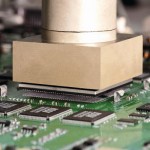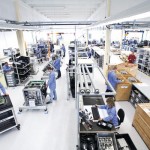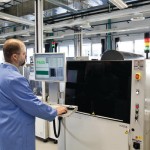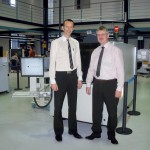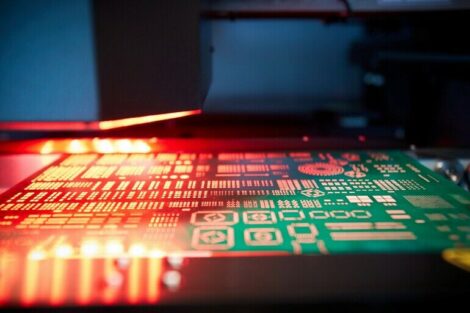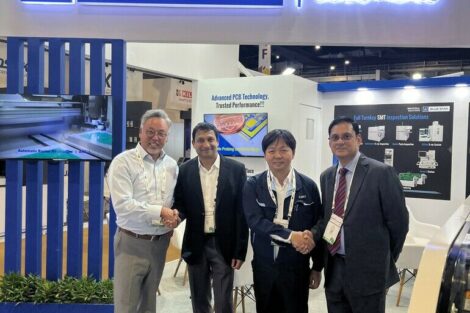The Zollner Elektronik AG is the only German company listed among the top 15 EMS manufacturers worldwide. The services offered a range from development of electronic/mechatronic products to after sales services. Just as comprehensive as their services is the wide range of branches for which Zollner works: these include automotive and industrial electronics, as well as medical technology, aviation and aerospace or telecommunications – to name but a few. In order to manufacture the widely varying products effectively, with high product quality and cost consciously, the equipment used in electronic assembly production must also fulfill the company philosophy of innovative strength and flexibility.
Viscom, Hannover (Germany) & Zollner Elektronik, Zandt (Germany)
This is why since 2003, systems for automatic optical inspection (AOI) and X-ray inspection (AXI) have ensured the quality of these electronic assemblies. To raise test coverage even further and attain the requisite flexibility at low cost, Zollner conducted an extensive evaluation of the inspection systems available on the market and decided to augment the previous AXI solutions with X7056 inspection systems from Viscom. With this inspection system, it is now possible for the company to realize both AOI as well as automatic X-ray inspection (AXI) in just one system. Thanks to the flexible inspection concept, both visible as well as hidden defects are detected quickly and reliably – with simple program setup and very high throughput.
Partner for electronic system solutions
Since it was founded in 1965, this company has remained in family ownership. At 15 international locations and with over 7,000 employees worldwide, the company offers system services for every phase of the product life cycle. This reaches from customer-specific development through material and supply chain management, up to production and after sales service. On average, more than 2,600 new product startups in customer contracts are realized annually. In the process, personal support and customer involvement are most essential to Zollner. When asked regarding its recipe for success, the company first refers to its all-embracing competence and technological leading edge, but also to absolute reliability and quality along with cost consciousness in production.
The challenges in production of electronics assemblies are particularly strongly determined by developments in the components field. The trend is towards ever tighter packaging density and smaller component types. Quite often, the connections are hidden beneath the component. High frequency applications often require shielding plates. After the reflow process, the solder joints beneath them can only be inspected with difficulty. Nonetheless, even here a 100 % defect-free assembly must be guaranteed. This all adds up to rising demands on flexibility during production. In this setting, a pure orthogonal AOI inspection has no chance. In order to detect potential defects, usually a X-ray inspection is employed. Because the AOI still offers obvious advantages due to its speed, it makes sense to investigate whether an AOI with angled view is adequate. Thus, the strategy is: as much AOI as possible, as much AXI as needed.
Therefore, those responsible at Zollner began a search for a new solution that would be suitable in both large series production as well as high-mix low-volume. Uwe Schulze, responsible for AOI and AXI in the inspection technology area, summarizes this situation as follows: „Our vision is, ‚We develop and produce faster, technologically better and more flexibly than our market competitors. This results in a clear competitive advantage for our customers.‘ Our equipment must also be capable of meeting this claim. The flexibility of the system was especially crucial for us, because the different assemblies also necessitate different AOI and AXI test concepts.“
AOI/AXI versus 3-D AXI
Previously, Zollner employed X-ray inspection systems which had been designed exclusively for a pure 3-D X-ray inspection. When deployed in series production, this restriction to full surface 3-D AXI presented certain disadvantages. Uwe Schulze describes these experiences: „It doesn’t always make sense to 3-D X-ray the entire assembly. The cycle time is simply shorter when an AOI is also used. Full surface 3-D X-ray inspection is very time-intensive and further, acquisition of these systems is very expensive. Viscom systems make it possible to graduate the inspection. The more I can inspect optically, the faster is the entire inspection. We have never had such flexibility before; this presents a true advantage.“ The heart of the X7056 X-ray technology is the high capacity, microfocus X-ray tube from Viscom. On the one hand, it offers high performance, where even heat sinks or shielding plates do not represent any obstruction. On the other, a resolution of 5, 7 or 10 µm per pixel can be selected in the X-ray section. Depending on the application, 3-D, 2.5-D or 2-D X-ray technologies are employed to achieve the highest inspection depth and short cycle times. In addition, thanks to the integration of the optical 8M sensor technology, the system also offers the high inspection depth of the Viscom AOI systems with a comparable throughput. The OnDemandHR function offers the possibility to flexibly switch the resolution from 23.4 to 11.7 µm/pixel with full image field size for each analysis. The EMS company deploys the X7056 systems for complex assemblies and especially for inspection of QFNs and BGAs. Although they appear simple to the casual glance, the exposed stamped edges of QFN components are considered to be a greater inspection challenge than the very stable standard BGAs. MicroBGAs with raster dimensions in the fine pitch range are also considered to be demanding for inspection. Uwe Schulze continues: „With AOI, such features as presence, displacement, polarity and solder quality were checked. Among its other applications, the AXI function is used to inspect not only where hidden menisci are only visible with difficulty, but also where taller components introduce shadowing.“
Setting ups
One important factor during the selection of an inspection system is inspection program creation. Especially where products change frequently, it is essential that inspection programs can be created quickly and conveniently. In this regard, the ability to operate two different inspection concepts at the same time in one system proves advantageous. „With our previous AXI system, the programming was difficult and hardly convenient. In contrast, with Viscom software we have the same surface for both AOI and AXI. The change between AOI and AXI is therefore very easy. This way, we are faster and more flexible,“ says Uwe Schulz. Despite the combination of cameras and X-ray tube, programming and inspection plan creation cost the operator no additional effort. The current CAD data and libraries remain completely compatible. And Uwe Schulze continues, „What we like is the possibility of offline programming. With the multi-picture image recording and video bases Viscom provides, we can now accomplish up to 90 % offline. This is a great advantage, because the systems are inline and the entire process no longer needs to be halted.“
Because of the increased flexibility of inspection with the X7056, Zollner has brought many advantages to daily work. Since the inspection strategy can now be oriented to the specific assembly and program creation is also faster and easier, cycle times could be significantly improved. Further, offline programming and intelligent inspection tools increase convenience during inspection.
Uwe Schulze summarizes this as follows: „The absolute plus is definitely the combination of AOI and AXI. Through the full-fledged AOI, it is not only possible to determine information in addition to the AXI, such as polarity marks, barcode recognition, component inscriptions etc., but also to completely inspect solder joints.“ In conclusion, he states: „And when this is viewed against the background of cycle time and component test coverage, it is obvious the inspection combination with the fully equipped AOI section of the X7056 presents tremendous advantages.“
productronica, A2.177 + B2.227
ZUSAMMENFASSUNG
Mit dem Einsatz des Inspektionssystem X7056 konnte Zollner Elektronik sowohl AOI als auch automatische Röntgeninspektion (AXI) mit einer Maschine realisieren. Das flexible Inspektionskonzept bringt dem Unternehmen viele Vorteile, wie der Artikel zeigt.
Grâce à l’utilisation du système d’inspection X7056, Zollner Elektronik a pu réaliser tant l’AOI que l’inspection radiologique automatique (AXI) avec une machine. Ainsi que le montre l’article, le concept d’inspection flexible offre de nombreux avantages à l’entreprise.
Share:





